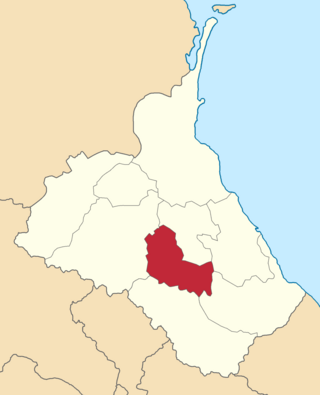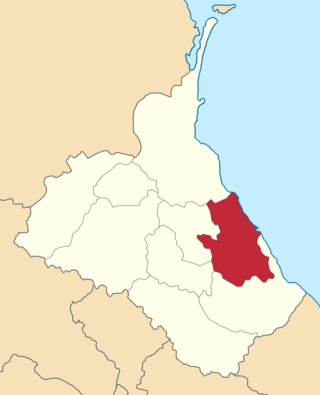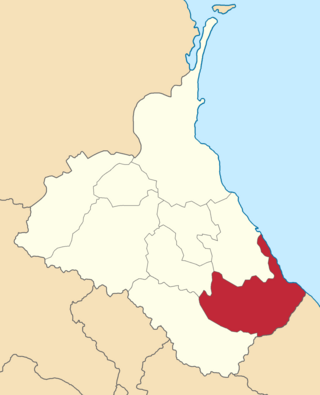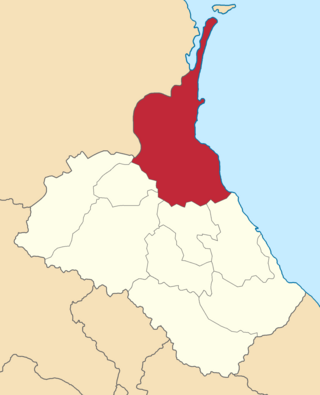
The Dagestan oblast was a province (oblast) of the Caucasus Viceroyalty of the Russian Empire. It roughly corresponded to most of present-day southeastern Dagestan within the Russian Federation. The Dagestan oblast was created in 1860 out of the territories of the former Caucasian Imamate, bordering the Terek Oblast to the north, the Tiflis Governorate and Zakatal Okrug to the west, the Elizavetpol Governorate to the south, and Baku Governorate to the east. The administrative center of the oblast was Temir-Khan-Shura.

The Kuban oblast was a province (oblast) of the Caucasus Viceroyalty of the Russian Empire. It roughly corresponded to most of the Kuban and Circassia regions. It was created in 1860 out of Kuban Cossack territories that had once been part of the Crimean Khanate and the land of the Circassians. It was dissolved upon the assumption of supreme authority by the Kuban Rada in 1917 and the independence of the Kuban People's Republic in 1918. Its capital was the city of Yekaterinodar.

The Zakatal or Zakatali okrug was a special administrative district (okrug) of the Caucasus Viceroyalty of the Russian Empire, part of the Tiflis Governorate from 1893 to 1905. The administrative centre of the district was Zakataly, and it corresponded to most of the contemporary districts of Balakan, Zaqatala and Qax of Azerbaijan. The Zakatal okrug was established from the territories of the erstwhile Free Jamaats of Jar-Balakan, bordering the Tiflis Governorate to the west, the Elizavetpol Governorate to the south and the Dagestan Oblast to the north. The district was unique in that it was the smallest independent administrative unit of the Russian Empire, similarly to the Sukhumi okrug.

The Sukhumi or Sukhum okrug was a special administrative district (okrug) in the Caucasus Viceroyalty of the Russian Empire, part of the Kutaisi Governorate from 1883 until 1905. The administrative center of the district was the Black Sea port city of Sukhum. The okrug bordered the Kutaisi Governorate to the southwest, the Kuban Oblast to the north and the Black Sea Governorate to the northwest and in terms of its area corresponded to most of contemporary Abkhazia. During 1905–1917, the Sukhumi okrug was one of the smallest independent administrative units of the Russian Empire, second to the Zakatal okrug.

The Javad uezd, known after 1921 as the Salyan uezd, was a county (uezd) within the Baku Governorate of the Russian Empire and then of the Azerbaijan Democratic Republic and Azerbaijan SSR until its formal abolishment in 1929 by the Soviet authorities. The uezd was located in the central part of the governorate, bordering the Geokchay, Shemakha, and Baku uezds to the north, Caspian sea to the east, Lenkoran uezd to the south and Iran to the west. The administrative center of the uezd was the city of Salyan.

The Baku uezd was a county (uezd) within the Baku Governorate of the Russian Empire and then of Azerbaijan Democratic Republic and Azerbaijan SSR until its formal abolishment in 1929. The uezd was located in eastern part of the Baku Governorate, bordering Caspian sea to the east, Shemakha uezd to the west, Kuba uezd to the north and Lenkoran uezd to the south. The administrative center of the uezd was the village Sarai.

The Lenkoran uezd or Talysh uezd was a county (uezd) within the Baku Governorate of the Russian Empire, and then of the Azerbaijan Democratic Republic and the Azerbaijan SSR until its formal abolishment in 1929. The county was located on the southern part of the governorate, bordering Caspian sea to the east, Javad uezd to the north, and Iran to the southwest. The administrative centre of the county was the city of Lenkoran.

The Kuba uezd was a county (uezd) within the Baku Governorate of Russian Empire and then of Azerbaijan Democratic Republic and Azerbaijan SSR until its formal abolition in 1929 by Soviet authorities. The uezd was located in northern part of the Baku Governorate, bordering Caspian sea to the east, Elizavetpol Governorate to the west, Dagestan Oblast to the north, the Geokchay, Shemakha, and Baku uezds to the south. The administrative center of the uezd was the city of Kuba.

The Baku gradonachalstvo was a municipal district (gradonachalstvo) based around the city of Baku in the Caucasus Viceroyalty of the Russian Empire. The Baku gradonachalstvo was formed in 1906 on the territory of the Baku uezd of the Baku Governorate following the Armenian–Tatar Massacres, until its disestablishment after the revolution of 1917. The area of the Baku gradonachalstvo corresponded to the Absheron Peninsula, located in easternmost present-day Azerbaijan.

The Geokchay uezd was a county (uezd) of the Baku Governorate of the Russian Empire and then of the Azerbaijan Democratic Republic and Azerbaijan SSR until its formal abolishment in 1929. The uezd was located in the central part of the governorate, bordering the Kuba uezd to the north, the Shemakha uezd to the east, the Javad uezd to the south and the Elizavetpol Governorate to the west. The administrative center of the uezd was the city of Geokchay.

The Batumi okrug was a district (okrug) of the Batum Oblast of the Russian Empire existing between 1878 and 1918. The district was eponymously named for its administrative center, the town of Batum, now part of Adjara within Georgia. The okrug bordered with the Artvin okrug in the south, the Ardahan okrug of the Kars Oblast to the southeast, the Tiflis Governorate to the northeast, the Kutaisi Governorate to the north, and the Trebizond Vilayet of the Ottoman Empire to the west.

The Avarsky okrug was a district (okrug) of the Dagestan Oblast of the Caucasus Viceroyalty of the Russian Empire. The area of the Avarsky okrug is included in contemporary Dagestan of the Russian Federation. The district's administrative centre was Khunzakh.

The Andiysky okrug was a district (okrug) of the Dagestan Oblast of the Caucasus Viceroyalty of the Russian Empire. The area of the Andiysky okrug is included in contemporary Dagestan of the Russian Federation. The district's administrative centre was Botlikh.

The Gunibsky okrug was a district (okrug) of the Dagestan Oblast of the Caucasus Viceroyalty of the Russian Empire. The area of the Gunibsky okrug is included in contemporary Dagestan of the Russian Federation. The district's centre was Gunib.

The Darginsky okrug was a district (okrug) of the Dagestan Oblast of the Caucasus Viceroyalty of the Russian Empire. The area of the Darginsky okrug is included in contemporary Dagestan of the Russian Federation. The district's administrative centre was Levashi.

The Kazikumukhsky okrug was a district (okrug) of the Dagestan Oblast of the Caucasus Viceroyalty of the Russian Empire. The area of the Kazikumukhsky okrug is included in contemporary Dagestan of the Russian Federation. The district's administrative centre was Kumukh.

The Kaytago-Tabasaransky okrug was a district (okrug) of the Dagestan Oblast of the Caucasus Viceroyalty of the Russian Empire. The area of the Kaytago-Tabasaransky okrug is included in contemporary Dagestan of the Russian Federation. The district's administrative centre was Madzhalis.

The Kyurinsky okrug was a district (okrug) of the Dagestan Oblast of the Caucasus Viceroyalty of the Russian Empire. The area of the Kyurinsky okrug is included in contemporary Dagestan of the Russian Federation. The district's administrative centre was Kasumkent.

The Temir-Khan-Shurinsky okrug was a district (okrug) of the Dagestan Oblast of the Caucasus Viceroyalty of the Russian Empire. The area of the Temir-Khan-Shurinsky okrug is included in contemporary Dagestan of the Russian Federation. The district's administrative centre was Temir-Khan-Shura.

The Groznensky okrug was a district (okrug) of the Terek Oblast of the Caucasus Viceroyalty of the Russian Empire. The area of the Groznensky okrug made up part of the North Caucasian Federal District of Russia. The district was eponymously named for its administrative centre, Grozny.





















